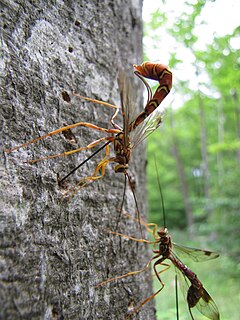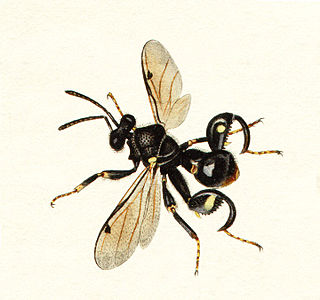
Danainae is a subfamily of the family Nymphalidae, the brush-footed butterflies. It includes the Daniadae, or milkweed butterflies, who lay their eggs on various milkweeds on which their larvae (caterpillars) feed, as well as the clearwing butterflies (Ithomiidae), and the tellervini.

A parasitoid is an organism that lives in close association with its host and at the host's expense, and which sooner or later kills it. Parasitoidism is one of six major evolutionary strategies within parasitism, distinguished by the fatal prognosis for the host, which makes the strategy close to predation.

The Ichneumonidae, also known as ichneumon wasps, is a parasitoid wasp family within the insect order Hymenoptera. This insect family, which so famously stirred skeptic thoughts in Charles Darwin, is among the most species-rich branches of the tree of life. At the same time, it is one of the groups for which our knowledge most severely lags behind their actual diversity. The roughly 25,000 species described today probably represent less than a quarter of their true richness, but reliable estimates are lacking, as is much of the most basic knowledge about their ecology, distribution and evolution. Ichneumonid wasps, with very few exceptions, attack the immature stages of holometabolous insects and spiders, eventually killing their hosts. They thus fulfill an important role as regulators of insect populations, both in natural and semi-natural systems, making them promising agents for biological control.

The Tiphiidae are a family of large solitary wasps whose larvae are parasitoids of various beetle larvae, especially those in the superfamily Scarabaeoidea. Until recently, this family contained several additional subfamilies, but multiple studies have independently confirmed that these comprise a separate lineage, and are now classified in the family Thynnidae.

The Braconidae are a family of parasitoid wasps. After the closely related Ichneumonidae, braconids make up the second-largest family in the order Hymenoptera, with about 17,000 recognized species and many thousands more undescribed. One analysis estimated a total between 30,000 and 50,000, and another provided a narrower estimate between 42,000 and 43,000 species.

Pipunculidae is a family of flies (Diptera) commonly termed big-headed flies, a reference to the large (holoptic) eyes, which cover nearly the entire head. The family is found worldwide and more than 1300 species have been described.

The Eulophidae are a large family of hymenopteran insects, with over 4,300 described species in some 300 genera. The family includes the genus Elasmus, which used to be treated as a separate family, "Elasmidae", and is now treated as a subfamily of Eulophidae. These minute insects are challenging to study, as they deteriorate rapidly after death unless extreme care is taken, making identification of most museum specimens difficult. The larvae of a very few species feed on plants, but the majority are primary parasitoids on a huge range of arthropods at all stages of development. They are exceptional in that they are one of two hymenopteran families with some species that are known to parasitize Thysanoptera. Eulophids are found throughout the world in virtually all habitats.

Parasitoid wasps are a large group of hymenopteran superfamilies, with all but the wood wasps (Orussoidea) being in the wasp-waisted Apocrita. As parasitoids, they lay their eggs on or in the bodies of other arthropods, sooner or later causing the death of these hosts. Different species specialise in hosts from different insect orders, most often Lepidoptera, though some select beetles, flies, or bugs; the spider wasps (Pompilidae) exclusively attack spiders.

The Trigonalidae are one of the more unusual families of hymenopteran insects, of indeterminate affinity within the suborder Apocrita, and presently placed in its own superfamily, Trigonaloidea. The Trigonalidae are divided into two subfamilies, Orthogonalinae and Trigonalinae. These wasps are extremely rare, but surprisingly diverse, with some 90 species in over 15 genera, and are known from all parts of the world.

Commonly known as cuckoo wasps or emerald wasps, the hymenopteran family Chrysididae is a very large cosmopolitan group of parasitoid or kleptoparasitic wasps, often highly sculptured, with brilliant metallic colors created by structural coloration. They are most diverse in desert regions of the world, as they are typically associated with solitary bee and wasp species, which are also most diverse in such areas.“Their brood parasitic lifestyle has led to the evolution of fascinating adaptations, including chemical mimicry of host odours by some species.

The Eucharitidae are a family of parasitic wasps. Eucharitid wasps are members of the superfamily Chalcidoidea and consist of three subfamilies: Oraseminae, Eucharitinae, and Gollumiellinae. Most of the 55 genera and 417 species of Eucharitidae are members of the subfamilies Oraseminae and Eucharitinae, and are found in tropical regions of the world.

The Chalcididae are a moderate-sized family within the Chalcidoidea, composed mostly of parasitoids and a few hyperparasitoids. The family is apparently polyphyletic, though the different subfamilies may each be monophyletic, and some may be elevated to family status in the near future. As presently defined, there are over 85 genera and over 1460 species worldwide. They are often black with yellow, red, or white markings, rarely brilliantly metallic, with a robust mesosoma and very strong sculpturing. The hind femora are often greatly enlarged, with a row of teeth or serrations along the lower margin.

Eupelmidae is a family of parasitic wasps in the superfamily Chalcidoidea. The group is apparently polyphyletic, though the different subfamilies may each be monophyletic, and may be elevated to family status in the near future. As presently defined, there are over 905 described species in 45 genera. The larvae of the majority are primary parasitoids, commonly on beetle larvae, though many other hosts are attacked, including spiders, and details of the life history can be variable. They are found throughout the world in virtually all habitats.

The Eurytomidae are a family within the superfamily Chalcidoidea. The group is apparently polyphyletic, though the different subfamilies may each be monophyletic, and may be elevated to family status in the near future. As presently defined, some 1420 species in 87 genera are described.

The Diapriidae are a family of parasitoid wasps. These tiny insects have an average length of 2–4 mm and never exceed 8 mm. They typically attack larvae and pupae of a wide range of insects, especially flies. The about 2,300 described species in 150 genera are divided into three subfamilies, and the group has a global distribution.

A wasp is any insect of the order Hymenoptera and suborder Apocrita that is neither a bee nor an ant. The Apocrita have a common evolutionary ancestor and form a clade; wasps as a group do not form a clade, but are paraphyletic with respect to bees and ants.
Scirpophaga excerptalis, the white top borer or sugarcane top borer, is a moth in the family Crambidae. It was described by Francis Walker in 1863. It is found in southern Asia from the Indian Subcontinent in the west to southern China in the east, south to New Guinea, possibly Australia and the Solomon Islands.
Aphidius nigripes is a species of parasitoid wasp in the subfamily Aphidiinae of the family Braconidae. It is the most common parasitoid of the potato aphid Macrosiphum euphorbiae in eastern North America. Many other species of aphids may also serve as hosts.

Tetraschininae is a subfamily of the chalcid wasp family Eulophidae. It is one of the largest subfamilies of the Eulophidae containing over 100 genera and nearly 3,000 species. The species of the family Tetrastichinae are found in almost any type of terrestrial habitat and have a worldwide distribution, except Antarctica. They show a varied biology and hosts for Tetraschine wasps have been identified from over 100 different insect families, across 10 different orders and they have also been recorded as being parasitoids on nematodes, mites and spiders' eggs. Some species are even phytophagous, while others are inquilines and yet others are gall formers.

















